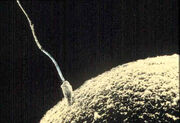Assessment |
Biopsychology |
Comparative |
Cognitive |
Developmental |
Language |
Individual differences |
Personality |
Philosophy |
Social |
Methods |
Statistics |
Clinical |
Educational |
Industrial |
Professional items |
World psychology |
Developmental Psychology: Cognitive development · Development of the self · Emotional development · Language development · Moral development · Perceptual development · Personality development · Psychosocial development · Social development · Developmental measures
Human development is the process of growing to maturity and reaching one's full potential. In biological terms, this entails growth from a one-celled zygote to an adult human being. The psychological study of human development is called developmental psychology.
We can conceive of human development in a variety of ways. In political-economic terms, human development has to do with stability, security and relative prosperity. In social terms, it has to do with literacy, education, social relationships, quality of life, etc. In moral terms, it has to do with the development of the conscience, moral awareness, and the will and capacity to act according to our knowledge of what is right. In psychological terms, human development has to do with mental health, self-esteem, success in significant relationships, happiness
Biological development

A spermatozoon fertilizing an ovum
Development begins with fertilization, the process by which the male gamete, the sperm cell, and the female gamete, the oocyte, fuse to give rise to a diploid cell, the zygote.
In medicine, pregnancy is defined as beginning when a fertilized zygote becomes implanted in a woman's uterus. This occurs when the zygote then becomes embedded into the endometrium (lining of the uterus) where it forms a placenta, for the purpose of receiving essential nutrients through the uterus wall. The umbilical cord in a newborn child signifies the remnants of implantation.
The zygote undergoes rapid mitotic divisions with no significant growth (a process known as cleavage) and cellular differentiation, leading to development of an embryo.
Childbirth is the process in which the baby is born. It is considered by many to be the beginning of a person's life, where age is defined relative to this event in most cultures.
Physical stages
Terms for stages of age-related physical development include, with their approximate age ranges:
- Zygote, the point of Conception, fertilization
- blastocyst the period between conception and embryonic stages
- Embryo; the embryonic period starts at three weeks and continues until the end of the 8th week of pregnancy
- Embryogenesis
- fetus; the fetal stage begins at the end of the 8th week and continues until childbirth
- Prenatal development
- Birth
- Child
- Infant (baby, newborn) (0-1.5)
- Toddler (1.5-4)
- Primary school age (also called prepubescence) (4-12)
- Elementary school age (also called middle childhood) (4-8)
- Preadolescence (preteen, or late childhood. The child in this and the previous phase are called schoolchild (schoolboy or schoolgirl), when still of primary school age.) (9-12)
- Adolescence and puberty (teenage) (13-19)
- Young adult (16-25)
- Adult (16-21 or older; exact minimum age may vary)
- Early adulthood (20-39)
- Middle age (40-59)
- Advanced adult/Senior citizen (60+)
- Death (occurs at various ages, depending on person)
Also sometimes used are terms that specify one's age in decades, such as:
- Twenty something (20-29)
- Thirty something (30-39)
- Forty something (40-49) (Formerly also Quadragenarian, rarely used since 1980)
- Quinquagenarian (50-59)
- Sexagenarian (60-69)
- Septuagenarian (70-79)
- Octogenarian (80-89)
- Nonagenarian (90-99)
- Centenarian (100-109)
- Supercentenarian (110+)
Physical development milestones
- Main article: Milestones of infant and child development
- Ability to lift and control the orientation of the head
- Crawling begins
- Walking begins
- Speech begins
- Voice lowers in pitch (especially noticeable in boys)
- Pubic hair appears
- Genitals and reproductive organs mature
- Menses begin (females)
- Body hair and facial hair appears
Note: the Tanner stages can be used to approximately judge a child's age based on physical development.
Further aspects of development linked to physical development
- Motor development
- Perceptual development
- Perceptual motor development
- Psychomotor development
- Psychosexual development
- Sexual development
Assessment
See also
- Evolutionary developmental psychology
- Evolutionary developmental psychopathology
- Life history theory
- Mammalian embryogenesis
- Neural development
References & Bibliography
Key texts
Books
Papers
Additional material
Books
Papers
External links
| This page uses Creative Commons Licensed content from Wikipedia (view authors). |